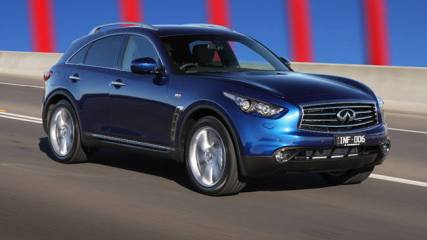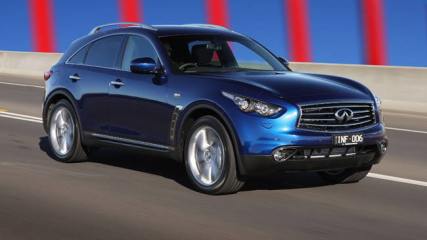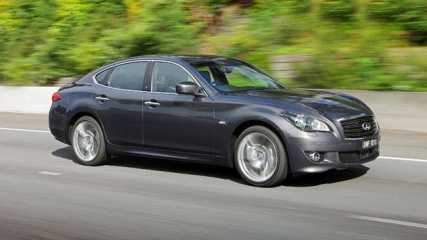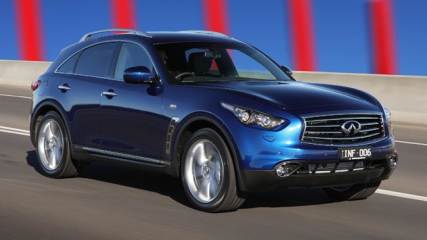Infiniti M Range 2012 Review
By Ewan Kennedy · 10 Sep 2012
Infiniti is back in Australia after a hiatus of 15 years and this time around is determined to become a major player in the premium area of the automotive arena.VALUEHeading the new Infiniti lineup is a sedan simply called the ‘Infiniti M’. The M range starts from $85,900 for the automatic M37 GT to the M35h GT Premium which starts from $99,900.The marketing guys tell us the Infiniti M is aimed at the sports luxury market currently occupied by BMW and Audi and to a lesser extent by Mercedes-Benz. But we feel it’s the technology guys who will become its biggest fans as it’s simply crammed with tech features, some of which haven’t been offered before.Incidentally, BMW is the only other marque to give buyers the choice between petrol, diesel and hybrid powerplants, in its 5 Series. (On a side note it’s good to see that the numbers in the Infiniti’s names - 37, 35, 30 - genuinely indicate the capacity of the engines, unlike the BMW powerplants where the numbering system has gone totally haywire in recent times!).Tech features abound in the new Infiniti, some of these are used in other premium European and Japanese cars, but are taken to further levels in the Infiniti.Radar cruise control is very simple to engage and seems to read the driver¹s mind the moment it¹s switched on.Infiniti drives who don¹t adjust the car¹s outside mirrors correctly are looked after by a blind-spot warning system. This is not an unusual feature these days, but Infiniti takes it one step further by also looking after drivers who aren¹t paying attention. If they wander from their lane the Infiniti M will apply the brakes on one side of the car to help steer it out of danger.DESIGNStyling is very much aimed at the sporting buyer, with a low-slung look, but with high wheel arches and a distinctive radiator grille. We find the appearance a bit untidy in places, with some bulgy bits that don¹t quite work. But there¹s no doubt that Infinitis stand out from the automotive crowd and that¹s more important than ever these days.Sound reduction in the cabin not only has the usual strengthening and noise damping items, but also uses active noise cancelling of the type seen in headphones used by travellers. Working in conjunction with Bose, a longtime expert in the field, Infiniti engineers have managed to further reduce interior noise.Having said that, all cars in this class, and indeed in lower-cost classes, are very quiet these days, so the added sound reduction in the Infiniti, while obviously there, isn¹t all that great.TECHNOLOGYInfiniti M is offered in three distinct models, the Infiniti M37 is powered by a 3.7-litre 235 kW V6 petrol engine; Infiniti M30d uses a 175 kilowatt 3.0-litre V6 turbo-diesel; we found the Infiniti M35h is the most interesting of them all, having a petrol-electric drivetrain using a 3.5-litre 225 kW petrol V6 and a parallel electric motor that can produce up to 50 kilowatts of power.Note that the maximum output from the M35h is 268 kW as the petrol and electric motors aren’t both delivering their best output simultaneously. In the way of all electric motors the Infiniti’s produces big torque at low revs, whereas the petrol engine concentrates on mid and upper levels.SAFETYInfiniti safety features include Intelligent Brake Assist (IBA), Forward Collision Warning (FCW) and Pre-Crash Safety Belts (front seats only). Should you still crash the Infiniti M has dual-stage front airbags, seat-mounted side impact airbags on the front seats, and roof-mounted curtain airbags.Infiniti drivers who don’t adjust the car’s outside mirrors correctly are looked after by a blind-spot warning system. This is not an unusual feature these days, but Infiniti takes it one step further by also looking after drivers who aren’t paying attention. If they wander from their lane the Infiniti M will apply the brakes on one side of the car to help steer it out of danger.DRIVINGWe have driven several models in the Infiniti M, including all three power trains, and have come away impressed by their sporting nature. Steering is precise and nicely weighted and gives the driver the feel that the car is very much working with them.Ride comfort is generally good, though some harsh Aussie roads did let bumps come through at times. To us as driving enthusiasts this occasional lack of comfort is quite acceptable.Our initial test drives in the south-east Queensland hinterland showed the Infiniti hybrid to have immense amounts of torque for climbing hills with ease and overtaking with maximum safety.Every Infiniti M model uses a seven-speed automatic transmission and, in the manner of upmarket European sedans, are driven by their rear wheels. The engine is set well back under the bonnet to further enhance the front-mid layout. This results in excellent handling balance that we really appreciated in the challenging roads on which we reviewed several Infiniti M models.A disadvantage of having the engines set well back in rear-drive cars is that the gearbox intrudes into the cabin, resulting in relatively limited foot width for those in the front seats.RANGEThe complete Infiniti M range is:M37 GT: from $85,900 (automatic)M37 S Premium: from $97,900 (automatic)M30d GT: from $87,900 (automatic)M30d S Premium: from $99,900 (automatic)M35h GT Premium: from $99,900 (automatic) Infiniti M37Prices: from $85,900 (GT), $97,900 (Premium)Engine:3.7l petrol V6, 235kW/360NmTransmission: 7-spd auto, RWDThirst: 10.2L/100km; 235g/km (CO2)Infiniti M30dPrices: from $87,900 (GT), $99,900 (Premium)Engine: 3.0l turbo-diesel V6, 175kW/550NmTransmission: 7-spd auto, RWDThirst: 7.5L/100km; 199g/km (CO2)Infiniti M35h SPrice: from $99,900Engine: 3.5l petrol V6 hybrid, 268kW/350Nm+270NmTransmission: 7-spd auto, RWDThirst: 6.9L/100km; 159g/km (CO2)Warranty: 4yrs/100,000kmService: 10,000km/6mths







-w.jpg)
